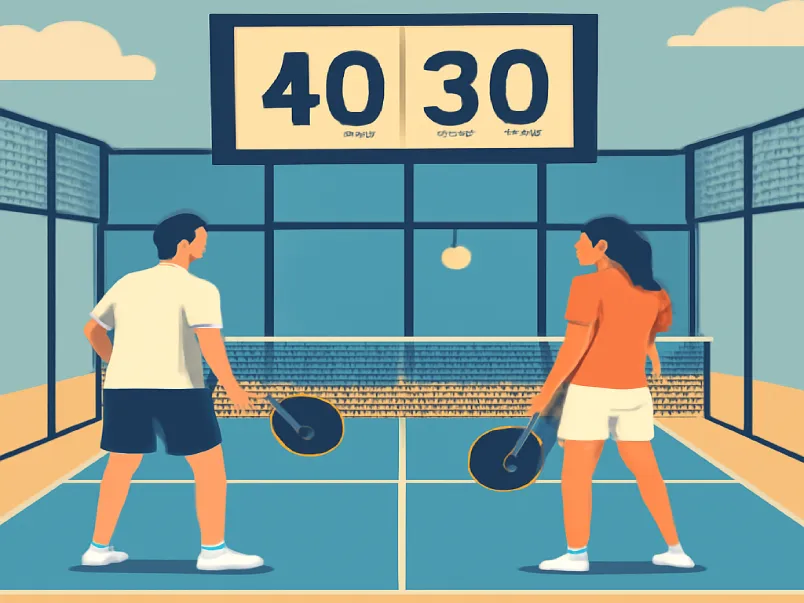Padel is a fun, fast-paced sport that has exploded in popularity around the world. Whether you’re stepping onto the court for the first time or just looking to sharpen your skills, understanding the scoring system is key to playing confidently. At first glance, the scoring might seem confusing—terms like “love-all,” “advantage server,” and “deuce” can leave beginners scratching their heads. However, once you break down the structure of the game, you’ll realize that padel scoring is simpler than it might appear. This article will guide you step-by-step through padel’s scoring system, making sure you’re ready to play like a pro in no time!
Why Padel Scoring is Simpler Than You Think
Hook: Picture this: You’re at your first padel game. The score is called out, “30-all,” or “Advantage Server.” You nod along, but inside, you’re wondering, “What does that even mean?” Sound familiar? Don’t worry—many players have been there.
Reassurance: The good news is that padel uses the same classic scoring system as tennis, which is familiar to many. So, if you’ve ever watched a tennis match, the basic concept will feel intuitive.
Promise: This article will break down the scoring system point by point, set by set, with clear examples to make you a scoring expert. By the end of this guide, you’ll feel completely comfortable following the score and playing with confidence.
1. The Basic Foundation: It’s Just Like Tennis
For those who are already familiar with tennis, padel scoring will feel very familiar. The general structure of the game, including how points, games, and sets are scored, is nearly identical to tennis. The key difference lies in the type of court used for padel and the number of players (typically two or four, depending on the format).
Key Similarities:
- Points: The point progression is the same as tennis: 0 (love), 15, 30, 40, and Game.
- Deuce and Advantage: If the score is tied at 40-40, it’s called “deuce,” and a player must win two consecutive points to win the game.
- Games and Sets: Just like in tennis, games are won by winning four points, and sets are won by the first team to win six games, provided they lead by at least two games.
Key Difference:
- The Court: While tennis is played on a flat surface, padel courts feature walls and glass barriers that add an exciting dimension to the game. Despite these differences, the scoring system remains unchanged.
2. Breaking Down the Points: Love, 15, 30, 40, Game
Let’s break down how points are scored during a single game. The progression is exactly the same as in tennis:
- 0 Points = Love: If no points have been won by a team, the score is called “love.”
- 1st Point = 15: After a team wins its first point, the score becomes “15.”
- 2nd Point = 30: After a second point is won, the score is “30.”
- 3rd Point = 40: Winning a third point brings the score to “40.”
- 4th Point = Game: If the team wins a fourth point and leads by at least one point, they win the game.
Example 1: A straightforward game win:
Team A wins four points in a row. Here’s how the score progresses:
- Love -> 15 -> 30 -> 40 -> Game.
3. Navigating the Ties: Deuce and Advantage
Now, let’s talk about what happens when the score gets tied at 40-40, also known as “deuce.” This is a crucial moment in a game that can stretch the match and make things interesting.
What is Deuce?
Deuce is the term used when both teams have won three points each, making the score 40-40. From this point, one team must win two consecutive points to win the game.
How to Win from Deuce:
After reaching deuce, a team must win two consecutive points to win the game. The sequence of the points is:
- First point after deuce: Whoever wins the first point gets the “Advantage.”
- Second point after Advantage: If the same team wins the next point, they win the game. If they lose the point, the score returns to deuce.
Example 2: A back-and-forth game at deuce.
The score is 40-40 (deuce). Here’s how it plays out:
- Team A wins a point: “Advantage Team A.”
- Team B wins the next point: “Deuce.”
- Team A wins another point: “Advantage Team A.”
- Team A wins the final point: “Game, Team A.”
4. Winning a Game and a Set
Winning a Game:
As we’ve already discussed, to win a game, a team must win four points, with a two-point lead. If the score reaches deuce, the team must win two consecutive points to secure the game.
Winning a Set:
A set is won by the first team to win six games, but there is a key condition: the winning team must have a two-game lead. This means scores like 6-4, 6-3, or 6-2 are common valid set scores.
- What happens at 6-5? The set continues until one team leads by two games. The score might go from 6-5 to 7-5.
- What happens at 6-6? A tie-break is played to determine the winner of the set.
5. The Tie-Break: Deciding a Set at 6-6
When the set score reaches 6-6, a tie-break is played to decide the set. The tie-break is a mini-game where players alternate serving, and points are counted numerically (1, 2, 3…) instead of using the traditional 15, 30, 40 format.
Scoring in the Tie-Break:
- Winning Condition: The first team to win 7 points wins the tie-break and the set. However, they must win by at least two points. So, the tie-break could end with scores like 7-5, 8-6, or even 9-7.
Serving in the Tie-Break:
- Teams alternate serving in a tie-break. The first team serves one point, and after that, teams alternate serving two points each.
Example 3: A Close Tie-Break
Imagine the score is 6-6 in the set, and a tie-break is played. After a tough back-and-forth, Team A wins the tie-break 8-6, thus winning the set 7-6.
6. Winning the Match: How Many Sets?
There are two main formats for winning a padel match:
- Best of Three Sets: This is the most common match format. The first team to win two sets wins the match.
- Best of One Set: In recreational or social play, sometimes a single set is enough to decide the match.
7. Calling the Score: A Practical Guide
During a match, it’s essential to know how to call the score correctly. Here’s the standard format for announcing the score:
- Server’s Score First: Always announce the server’s score first, followed by the receiver’s score.
Example:
- If the serving team has 2 points and the receiving team has 1 point, the correct call is: “30-15.”
Starting a New Game or Set:
- New Game: “Love-All.”
- New Set: “New set, Love-All.”
8. Common Scenarios & Quick Reference Chart
Here’s a simple table summarizing the key scenarios and the appropriate score calls:
| Situation | Score Call | What Happens Next? |
|---|---|---|
| Start of Game | Love-All | Play to 15, 30, 40, Game |
| Both teams have 1 point | 15-All | Continue to 30, 40, and then Game |
| Both teams have 3 points | 40-40 (Deuce) | Need 2 points in a row to win |
| Server leads after Deuce | Advantage Server | Next point wins the game or returns to Deuce |
| Set is tied 5-5 | 5-5 | First to 7 games, or win 6-5 and then 7-5 |
| Set is tied 6-6 | 6-6 | Play a 7-point Tie-Break |
Conclusion: You’re Ready to Play and Score!
Congratulations! You now have a solid understanding of padel scoring. From the progression of points to handling ties at deuce, winning games, sets, and navigating a tie-break, you’ve got all the tools to follow the score confidently during your next match.
Recap:
- Point progression: Love -> 15 -> 30 -> 40 -> Game.
- Deuce and Advantage: Win two consecutive points after deuce to win the game.
- Sets: Win 6 games to win a set, but must lead by 2 games. At 6-6, a tie-break is played.
- Match formats: Best of Three Sets or Best of One Set.
Encouragement:
The best way to learn padel scoring is to play! Whether you’re competing in a tournament or just enjoying some friendly games, understanding the scoring system will help you feel more in control and more confident on the court.
Now, get out there and start scoring your padel matches like a pro!
FAQs
1. What is the scoring system in padel?
The scoring system in padel is very similar to tennis. Points progress as: Love (0), 15, 30, 40, and Game. If the score reaches 40-40 (deuce), a player needs to win two consecutive points to win the game. Sets are won by the first team to win 6 games, with at least a 2-game lead.
2. How do you win a game in padel?
To win a game in padel, you must win four points with a two-point advantage. If the score reaches deuce (40-40), you must win two consecutive points to win the game.
3. What happens if the score is tied at 6-6 in a set?
When the score reaches 6-6 in a set, a tie-break is played. The first team to win 7 points in the tie-break, with a 2-point margin, wins the set.
4. What is the difference between padel and tennis scoring?
Padel scoring follows the same principles as tennis, including the point progression (Love, 15, 30, 40, Game), deuce, and advantage. The main difference is the use of walls and glass on the padel court, which changes the dynamics of the game but not the scoring system.
5. How do you call the score in padel?
When announcing the score, the server’s score is called first, followed by the receiver’s score. For example, if the serving team has 2 points and the receiving team has 1 point, the call is “30-15.”
6. What is the format for winning a match in padel?
There are two common formats for padel matches: Best of Three Sets (the first team to win two sets wins the match) and Best of One Set (one set decides the winner, often used in recreational play).




